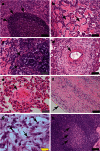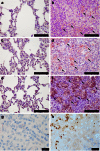Morphological characterization and immunohistochemical detection of the proinflammatory cytokines IL-1β, IL-17A, and TNF-α in lung lesions associated with contagious bovine pleuropneumonia
- PMID: 26837619
- PMCID: PMC4766205
- DOI: 10.1007/s11250-016-0994-9
Morphological characterization and immunohistochemical detection of the proinflammatory cytokines IL-1β, IL-17A, and TNF-α in lung lesions associated with contagious bovine pleuropneumonia
Abstract
Contagious bovine pleuropneumonia (CBPP), a severe respiratory disease, is characterized by massive inflammation of the lung especially during the acute clinical stage of infection. Tissue samples from cattle, experimentally infected with Mycoplasma mycoides subsp. mycoides Afadé, were subjected to histopathological and immunohistochemical examination in order to provide insight into innate immune pathways that shape inflammatory host responses. Lung lesions were characterized by vasculitis, necrosis, and increased presence of macrophages and neutrophils, relative to uninfected animals. The presence of three cytokines associated with innate inflammatory immune responses, namely, IL-1β, IL-17A, and TNF-α, were qualitatively investigated in situ. Higher cytokine levels were detected in lung tissue samples from CBPP-affected cattle compared to samples derived from an uninfected control group. We therefore conclude that the cytokines TNF-α and IL-1β, which are prevalent in the acute phase of infections, play a role in the inflammatory response seen in the lung tissue in CBPP. IL-17A gets released by activated macrophages and attracts granulocytes that modulate the acute phase of the CBPP lesions.
Keywords: CBPP; Contagious bovine pleuropneumonia; Cytokines; Histopathology; Immunocytochemistry; Mycoplasma mycoides subsp. mycoides.
Figures


Similar articles
-
Proteomic characterization of pleural effusion, a specific host niche of Mycoplasma mycoides subsp. mycoides from cattle with contagious bovine pleuropneumonia (CBPP).J Proteomics. 2016 Jan 10;131:93-103. doi: 10.1016/j.jprot.2015.10.016. Epub 2015 Oct 23. J Proteomics. 2016. PMID: 26476145
-
Plasma levels of TNF-α, IFN-γ, IL-4 and IL-10 during a course of experimental contagious bovine pleuropneumonia.BMC Vet Res. 2012 Apr 25;8:44. doi: 10.1186/1746-6148-8-44. BMC Vet Res. 2012. PMID: 22533922 Free PMC article.
-
Pathological, immunohistochemical and bacteriological findings in kidneys of cattle with contagious bovine pleuropneumonia (CBPP).J Comp Pathol. 2001 Feb-Apr;124(2-3):95-101. doi: 10.1053/jcpa.2000.0433. J Comp Pathol. 2001. PMID: 11222005
-
Contagious Bovine Pleuropneumonia: A Comprehensive Overview.Vet Pathol. 2020 Jul;57(4):476-489. doi: 10.1177/0300985820921818. Epub 2020 May 11. Vet Pathol. 2020. PMID: 32390522 Review.
-
Mycoplasma mycoides subspecies mycoides (small colony variant): the agent of contagious bovine pleuropneumonia and member of the "Mycoplasma mycoides cluster".J Comp Pathol. 1995 Jul;113(1):1-27. doi: 10.1016/s0021-9975(05)80065-9. J Comp Pathol. 1995. PMID: 7490334 Review. No abstract available.
Cited by
-
Reproduction of contagious bovine pleuropneumonia via aerosol-based challenge with Mycoplasma mycoides subsp. mycoides.Acta Vet Scand. 2020 Nov 16;62(1):62. doi: 10.1186/s13028-020-00560-0. Acta Vet Scand. 2020. PMID: 33198794 Free PMC article.
-
Pro-Inflammatory Response of Bovine Polymorphonuclear Cells Induced by Mycoplasma mycoides subsp. mycoides.Front Vet Sci. 2020 Mar 27;7:142. doi: 10.3389/fvets.2020.00142. eCollection 2020. Front Vet Sci. 2020. PMID: 32292794 Free PMC article.
-
Biological functions of IL-17-producing cells in mycoplasma respiratory infection.Immunology. 2021 Oct;164(2):223-230. doi: 10.1111/imm.13346. Epub 2021 May 19. Immunology. 2021. PMID: 33930194 Free PMC article. Review.
-
Interleukin-17A Exacerbates Disease Severity in BALB/c Mice Susceptible to Lung Infection with Mycoplasma pulmonis.Infect Immun. 2018 Aug 22;86(9):e00292-18. doi: 10.1128/IAI.00292-18. Print 2018 Sep. Infect Immun. 2018. PMID: 29986888 Free PMC article.
-
Host-Pathogen Interactions of Mycoplasma mycoides in Caprine and Bovine Precision-Cut Lung Slices (PCLS) Models.Pathogens. 2019 Jun 20;8(2):82. doi: 10.3390/pathogens8020082. Pathogens. 2019. PMID: 31226867 Free PMC article.
References
-
- Allie N, Grivennikov SI, Keeton R, Hsu NJ, Bourigault ML, Court N, Fremond C, Yeremeev V, Shebzukhov Y, Ryffel B, Nedospasov SA, Quesniaux VF, Jacobs M. Prominent role for T cell-derived tumour necrosis factor for sustained control of Mycobacterium tuberculosis infection. Scientific Reports. 2013;3:1809. doi: 10.1038/srep01809. - DOI - PMC - PubMed
-
- Caswell JL, Williams KJ. Respiratory System. In: Maxie MG, editor. Jubb, Kennedy, and Palmer’s Pathology of domestic animals, 2007. New York: Elsevier Saunders, Edinburgh; 2007. pp. 610–612.
-
- Dedieu L, Balcer-Rodrigues V, Yaya A, Hamadou B, Cisse O, Diallo M, Niang M. Gamma interferon-producing CD4 T-cells correlate with resistance to Mycoplasma mycoides subsp. mycoides S.C. infection in cattle. Veterinary Immunology and Immunopathology. 2005;107:217–233. doi: 10.1016/j.vetimm.2005.04.011. - DOI - PubMed
-
- Fischer, A., Santana-Cruz, I., Hegerman, J., Gourle, H., Schieck, E., Lambert, M., Nadendla, S., Wesonga, H., Miller, R.A., Vashee, S., Weber, J., Meens, J., Frey, J., Jores, J., 2015. High quality draft genomes of the Mycoplasma mycoides subsp. mycoides challenge strains Afadé and B237, Standarts in Genomic Sciences, 10, 89. - PMC - PubMed
Publication types
MeSH terms
Substances
LinkOut - more resources
Full Text Sources
Other Literature Sources

